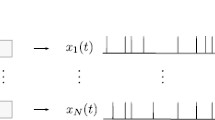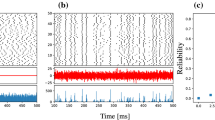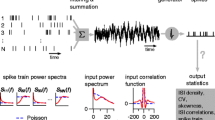Abstract
Spike timing is believed to be a key factor in sensory information encoding and computations performed by the neurons and neuronal circuits. However, the considerable noise and variability, arising from the inherently stochastic mechanisms that exist in the neurons and the synapses, degrade spike timing precision. Computational modeling can help decipher the mechanisms utilized by the neuronal circuits in order to regulate timing precision. In this paper, we utilize semi-analytical techniques, which were adapted from previously developed methods for electronic circuits, for the stochastic characterization of neuronal circuits. These techniques, which are orders of magnitude faster than traditional Monte Carlo type simulations, can be used to directly compute the spike timing jitter variance, power spectral densities, correlation functions, and other stochastic characterizations of neuronal circuit operation. We consider three distinct neuronal circuit motifs: Feedback inhibition, synaptic integration, and synaptic coupling. First, we show that both the spike timing precision and the energy efficiency of a spiking neuron are improved with feedback inhibition. We unveil the underlying mechanism through which this is achieved. Then, we demonstrate that a neuron can improve on the timing precision of its synaptic inputs, coming from multiple sources, via synaptic integration: The phase of the output spikes of the integrator neuron has the same variance as that of the sample average of the phases of its inputs. Finally, we reveal that weak synaptic coupling among neurons, in a fully connected network, enables them to behave like a single neuron with a larger membrane area, resulting in an improvement in the timing precision through cooperation.













Similar content being viewed by others
References
Adler, R. (1973). A study of locking phenomena in oscillators. Proceedings of the IEEE, 61(10), 1380–1385.
Attwell, D, & Laughlin, S B. (2001). An energy budget for signaling in the grey matter of the brain. Journal of Cerebral Blood Flow & Metabolism, 21(10), 1133–1145.
Bacci, A, & Huguenard, J R. (2006). Enhancement of spike-timing precision by autaptic transmission in neocortical inhibitory interneurons. Neuron, 49(1), 119–130.
Brown, E N, Moehlis, J, Holmes, P. (2004). On the phase reduction and response dynamics of neural oscillator populations. Neural Computation, 16(4), 673–715.
Buzsáki, G, & Draguhn, A. (2004). Neuronal oscillations in cortical networks. Science, 304(5679), 1926–1929.
Chiu, C S, Jensen, K, Sokolova, I, Wang, D, Li, M, Deshpande, P, Davidson, N, Mody, I, Quick, M W, Quake, S R, et al. (2002). Number, density, and surface/cytoplasmic distribution of gaba transporters at presynaptic structures of knock-in mice carrying gaba transporter subtype 1–green fluorescent protein fusions. Journal of Neuroscience, 22(23), 10,251–10,266.
Cover, TM, & Thomas, JA. (2012). Elements of information theory. Wiley.
Dayan, P, & Abbott, LF. (2001). Theoretical neuroscience. Cambridge: MIT Press.
De Smedt, V, Gielen, G, Dehaene, W. (2015). Injection-locked oscillators. In Temperature-and supply voltage-independent time references for wireless sensor networks (pp. 209–256). Springer.
Deleuze, C, Pazienti, A, Bacci, A. (2014). Autaptic self-inhibition of cortical gabaergic neurons: synaptic narcissism or useful introspection? Current Opinion in Neurobiology, 26, 64–71.
Demir, A. (2000). Floquet theory and non-linear perturbation analysis for oscillators with differential-algebraic equations. International Journal of Circuit Theory and Applications, 28(2), 163–185.
Demir, A. (2006). Computing timing jitter from phase noise spectra for oscillators and phase-locked loops with white and 1/f noise. IEEE Transactions on Circuits and Systems-I: Regular Papers, 53(9), 1869–1884.
Demir, A, & Roychowdhury, J. (2003). A reliable and efficient procedure for oscillator PPV computation, with phase noise macromodelling applications. IEEE Transaction on CAD of ICs and Systems, 22(2), 188–197.
Demir, A, & Sangiovanni-Vincentelli, A. (1998). Analysis and simulation of noise in nonlinear electronic circuits and systems. Kluwer Academic Publishers.
Demir, A, Mehrotra, A, Roychowdhury, J. (2000). Phase noise in oscillators: a unifying theory and numerical methods for characterization. IEEE Transactions on Circuits and Systems I: Fundamental Theory and Applications, 47(5), 655–674.
Demir, A, Gu, C, Roychowdhury, J. (2010). Phase equations for quasi-periodic oscillators. In IEEE/ACM International conference on computer-aided design.
Destexhe, A, Mainen, Z F, Sejnowski, T J. (1994). Synthesis of models for excitable membranes, synaptic transmission and neuromodulation using a common kinetic formalism. Journal of Computational Neuroscience, 1(3), 195–230.
Destexhe, A, Contreras, D, Steriade, M. (1998a). Mechanisms underlying the synchronizing action of corticothalamic feedback through inhibition of thalamic relay cells. Journal of Neurophysiology, 79(2), 999–1016.
Destexhe, A, Mainen, Z F, Sejnowski, T J. (1998b). Kinetic models of synaptic transmission. In Koch, C, & Segev, I (Eds.) Methods in neuronal modeling: from synapses to networks (pp. 1–26). Cambridge: MIT Press.
DiGiovanna, J, Nguyen, T, Guinand, N, Pérez-Fornos, A, Micera, S. (2016). Neural network model of vestibular nuclei reaction to onset of vestibular prosthetic stimulation. Frontiers in Bioengineering and Biotechnology, 4.
Esfahani, Z G, Gollo, L L, Valizadeh, A. (2016). Stimulus-dependent synchronization in delayed-coupled neuronal networks. Scientific Reports, 6.
Faisal, A A, Selen, L, Wolpert, D. (2008). Noise in the nervous system. Nature Reviews Neuroscience, 9 (4), 292–303.
Fitzhugh, R. (1965). A kinetic model of the conductance changes in nerve membrane. Journal of Cellular and Comparative Physiology, 66(S2), 111–117.
Fox, R F, & Lu, Y N. (1994). Emergent collective behavior in large numbers of globally coupled independently stochastic ion channels. Physical Review E, 49(4), 3421.
Gajic, Z, & Qureshi, MTJ. (2008). Lyapunov matrix equation in system stability and control. Courier Corporation.
Gardiner, C. (1983). Handbook of stochastic methods for physics, chemistry and the natural sciences. Springer-Verlag.
Ghazanfar, A A, & Schroeder, C E. (2006). Is neocortex essentially multisensory? Trends in Cognitive Sciences, 10(6), 278–285.
Gillespie, D T. (2007). Stochastic simulation of chemical kinetics. Annual Review of Physical Chemistry, 58, 35–55.
Goldwyn, J H, Imennov, N S, Famulare, M, Shea-Brown, E. (2011). Stochastic differential equation models for ion channel noise in Hodgkin-Huxley neurons. Physical Review E, 83(4), 041,908.
Grothe, B, & Klump, G M. (2000). Temporal processing in sensory systems. Current Opinion in Neurobiology, 10(4), 467–473.
Gu, C, Xu, J, Rohling, J, Yang, H, Liu, Z. (2015). Noise induces oscillation and synchronization of the circadian neurons. PLOS One, 10(12), e0145,360.
Gupta, S C. (1975). Phase-locked loops. Proceedings of the IEEE, 63(2), 291–306.
Hasenstaub, A, Shu, Y, Haider, B, Kraushaar, U, Duque, A, McCormick, D A. (2005). Inhibitory postsynaptic potentials carry synchronized frequency information in active cortical networks. Neuron, 47(3), 423–435.
Higham, D J. (2008). Modeling and simulating chemical reactions. SIAM Review, 50(2), 347–368.
Isaacson, J S, & Scanziani, M. (2011). How inhibition shapes cortical activity. Neuron, 72(2), 231–243.
Izhikevich, EM. (2007). Dynamical systems in neuroscience. MIT press.
Kilinc, D, & Demir, A. (2015). Simulation of noise in neurons and neuronal circuits. In Proceedings of the IEEE/ACM international conference on computer-aided design (ICCAD) (pp. 589-596). IEEE.
Kilinc, D, & Demir, A. (2017). Noise in neuronal and electronic circuits: a general modeling framework and Non-Monte Carlo simulation techniques. IEEE Transactions on Biomedical Circuits and Systems, 11(4), 958–974.
Kundert, K S, White, JK, Sangiovanni-Vincentelli, A. (1990). Steady-state methods for simulating analog and microwave circuits. Springer Science & Business Media.
Lennie, P. (2003). The cost of cortical computation. Current Biology, 13(6), 493–497.
Linaro, D, Storace, M, Giugliano, M. (2011). Accurate and fast simulation of channel noise in conductance-based model neurons by diffusion approximation. PLOS Computational Biology, 7(3), e1001,102.
Mahmutoglu, AG, & Demir, A. (2014). Modeling and analysis of nonstationary low-frequency noise in circuit simulators: enabling non Monte Carlo techniques. In Proceedings of the international conference on computer-aided design (pp. 309–315). IEEE Press.
Mainen, Z F, & Sejnowski, T J. (1995). Reliability of spike timing in neocortical neurons. Science, 268(5216), 1503.
Masugi-Tokita, M, Tarusawa, E, Watanabe, M, Molnár, E, Fujimoto, K, Shigemoto, R. (2007). Number and density of ampa receptors in individual synapses in the rat cerebellum as revealed by sds-digested freeze-fracture replica labeling. Journal of Neuroscience, 27(8), 2135–2144.
Miller, E K. (2000). The prefontral cortex and cognitive control. Nature Reviews Neuroscience, 1(1), 59–65.
Moujahid, A, d’Anjou, A, Torrealdea, F, Torrealdea, F. (2011). Energy and information in Hodgkin-Huxley neurons. Physical Review E, 83(3), 031,912.
Nowak, L G, Sanchez-Vives, M V, McCormick, D A. (1997). Influence of low and high frequency inputs on spike timing in visual cortical neurons. Cerebral Cortex, 7(6), 487–501.
Orio, P, & Soudry, D. (2012). Simple, fast and accurate implementation of the diffusion approximation algorithm for stochastic ion channels with multiple states. PLOS One, 7(5), e36,670.
Perrais, D, Veran, J, Mulle, C. (2010). Gating and permeation of kainate receptors: differences unveiled. Trends in Pharmacological Sciences, 31(11), 516–522.
Pinheiro, P, & Mulle, C. (2006). Kainate receptors. Cell and Tissue Research, 326(2), 457–482.
Pouille, F, & Scanziani, M. (2001). Enforcement of temporal fidelity in pyramidal cells by somatic feed-forward inhibition. Science, 293(5532), 1159–1163.
Razavi, B. (2004). A study of injection locking and pulling in oscillators. IEEE Journal of Solid-State Circuits, 39(9), 1415–1424.
Sharpeshkar, R. (2010). Ultra low power bioelectronics: fundamentals, biomedical applications, and bio-inspired system. Cambridge University Press.
Subrahmanyam, M. (1986). On a numerical method of solving the Lyapunov and Sylvester equations. International Journal of Control, 43(2), 433–439.
Suvak, O, & Demir, A. (2011). On phase models for oscillators. IEEE Transactions On Computer-Aided Design of Integrated Circuits and Systems, 30(7), 972–985.
Tank, D W, & Hopfield, J J. (1987). Collective computation in neuronlike circuits. Scientific American, 257 (6), 104–114.
VanRullen, R, Guyonneau, R, Thorpe, S J. (2005). Spike times make sense. Trends in Neurosciences, 28(1), 1–4.
Varga, Z, Jia, H, Sakmann, B, Konnerth, A. (2011). Dendritic coding of multiple sensory inputs in single cortical neurons in vivo. Proceedings of the National Academy of Sciences, 108(37), 15,420–15,425.
White, J A, Rubinstein, J T, Kay, A R. (2000). Channel noise in neurons. Trends in Neurosciences, 23 (3), 131–137.
Winfree, AT. (2001). The geometry of biological time. Springer.
Acknowledgements
This work was supported by the Scientific and Technological Research Council of Turkey (TÜBİTAK) under project 111E188.
The authors would like to thank two anonymous reviewers for their thoughtful and detailed feedback on an earlier version of the manuscript.
Author information
Authors and Affiliations
Corresponding author
Additional information
Action Editor: Susanne Schreiber
Appendix: : ion channel models
Appendix: : ion channel models
Neurons used in our numerical analyses include 18 K+ channels/μm2 and 60 Na+ VG channels/μm2 (Dayan and Abbott 2001). In analyzing various neuronal architectures, the number of excitatory and inhibitory synaptic receptor LG channels per synapse are varied, in accordance with the physiologically plausible values for the receptor channel densities, the number of synapses, and the membrane areas of the neurons (Masugi-Tokita et al. 2007; Chiu et al. 2002). We utilize well established kinetic schemes for K+ and Na+ channels, as shown in Fig. 14a and b (Dayan and Abbott 2001). Excitatory synapses include AMPA/kainate receptor channels with a kinetic scheme shown in Fig. 14c (Destexhe et al. 1998b). Inhibitory synapses include GABA A receptor channels having a kinetic scheme illustrated in Fig. 14d (Destexhe et al. 1998b).
The transition rates we use for the kinetic models of K+ and Na+ channels are given by
where V (t) is the membrane potential of the neuron as described by Eq. (1) and expressed in mV, α i ’s and β i ’s are expressed in msec− 1 (Dayan and Abbott 2001). The ionic K+ and Na+ currents are given by
where \(g_{\mathrm {K}^{+}}=g_{\text {Na}^{+}}= 20\) pS, \(E_{\mathrm {K}^{+}}=-77\) mV, \(E_{\text {Na}^{+}}= 50\) mV, \(N_{n^{4}}\) and \(N_{m^{3}h^{1}}\) are the total number of open K+ and Na+ channels, respectively (Dayan and Abbott 2001).
Nominal values for the transition rates in the kinetic model of the AMPA/kainate receptor channel, i.e., \(R_{b}([L(t)])= 1.3\times 10^{7}[L(t)], R_{u_{1}}= 5.9\times 10^{0}, R_{u_{2}}= 8.6\times 10^{4}, R_{r}= 6.4\times 10^{1}, R_{d}= 9.0\times 10^{2},R_{c}= 2.0\times 10^{2}\), and R o = 2.7 × 103 (all in units of s− 1), are given in (Destexhe et al. 1998b). The results presented in Section 5 were obtained based on these transition rates for the AMPA/kainate receptor channel. With these values, the synaptic delay is approximately 1 msec. In order to increase the synaptic delay (between the spikes generated in the presynaptic and postsynaptic neuron connected via an excitatory synapse) by ∼1 msec to 2 msec, we also use updated transition rates for the AMPA/kainate receptor channels, given by \(R_{b}([L(t)])= 1.0\times 10^{6}[L(t)], R_{u_{1}}= 3.0\times 10^{1}, R_{u_{2}}= 1.6\times 10^{5}, R_{r}= 3.4\times 10^{1}, R_{d}= 8.4\times 10^{2}, R_{c}= 3.7\times 10^{2}\), and R o = 0.9 × 103 (all in units of s− 1). The results presented in Sections 4 and 6 were obtained based on these updated transition rates for the AMPA/kainate receptor channel. These updated values are justified based on the diversity of activation and desensitization properties of AMPA/kainate receptor channels that is described in Pinheiro and Mulle (2006) and Perrais et al. (2010). For neurons that are reciprocally connected by excitatory and inhibitory synapses, a synaptic delay that is shorter than the depolarization duration of an action potential would result in a premature inhibition of the action potential. Thus, a ∼1 msec increase in the synaptic delay makes the neuronal dynamics more physiologically meaningful. Prolonged synaptic delays can alternatively be modeled via distributed multi-compartment synapse or neuron models.
The transition rates in the kinetic model of the GABA A receptor channel are set to \(R_{b_{1}}([L(t)])= 2.0\times 10^{7}[L(t)], R_{b_{2}}([L(t)])= 1.0\times 10^{7}[L(t)], R_{u_{1}}= 4.6\times 10^{3}, R_{u_{2}}= 9.2\times 10^{3}, R_{c_{1}}= 9.8\times 10^{3}, R_{c_{2}}= 4.1\times 10^{2}, R_{o_{1}}= 3.3\times 10^{3}\), and \(R_{o_{2}}= 1.1\times 10^{4}\) (all in units of s− 1), as given in Destexhe et al. (1998b).
[L(t)] is the concentration of neurotransmitter molecules in the synaptic cleft, given by
where Lmax = 2.84 × 10− 3 M is the maximal concentration, Vpre(t) is the membrane potential of the presynaptic neuron expressed in mV, K p = 5 mV is the steepness parameter and V p = 2 mV determines the value at which the concentration is half of the maximum value (Destexhe et al. 1994). The ionic AMPA and GABA A currents are given by
where gAMPA = gGABA = 20 pS, EAMPA = 0 mV, \(E_{\text {GABA}_{A}}=-70\) mV, N O and \(N_{O_{1}}+N_{O_{2}}\) are the total number of open AMPA and GABA A receptor channels, respectively (Destexhe et al. 1998b).
Rights and permissions
About this article
Cite this article
Kilinc, D., Demir, A. Spike timing precision of neuronal circuits. J Comput Neurosci 44, 341–362 (2018). https://doi.org/10.1007/s10827-018-0682-z
Received:
Revised:
Accepted:
Published:
Issue Date:
DOI: https://doi.org/10.1007/s10827-018-0682-z





